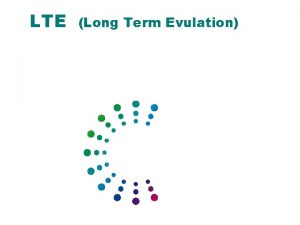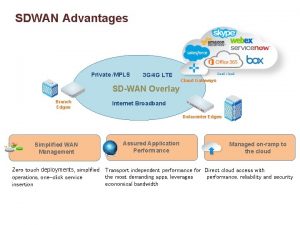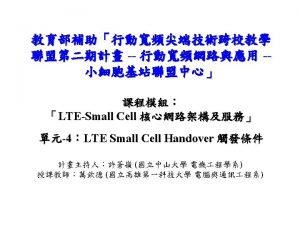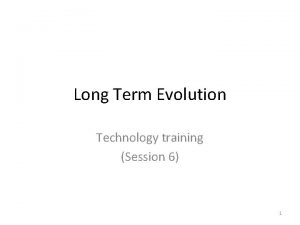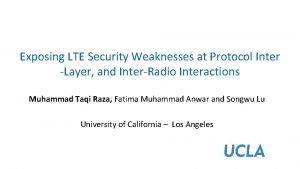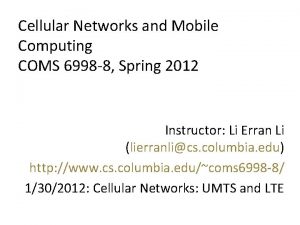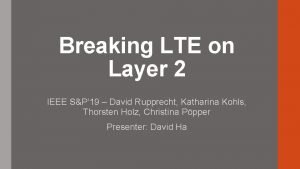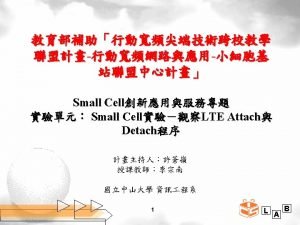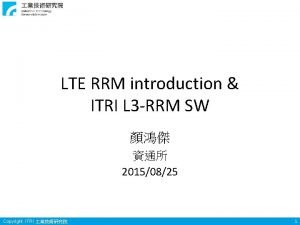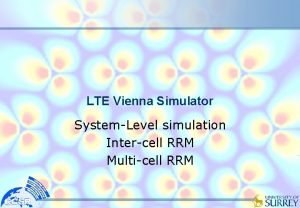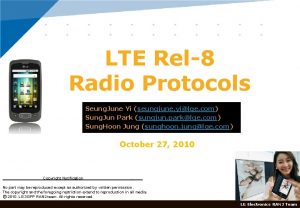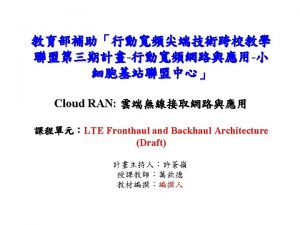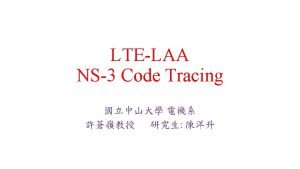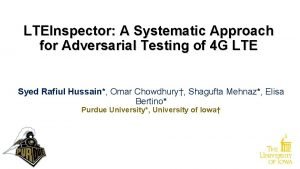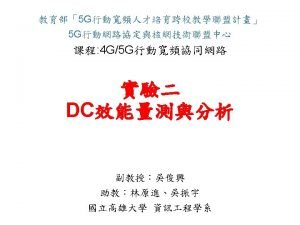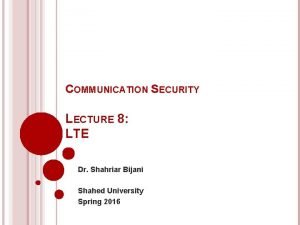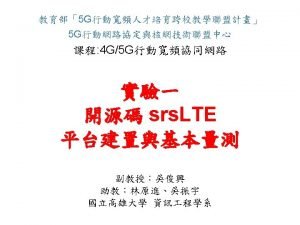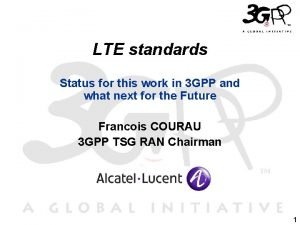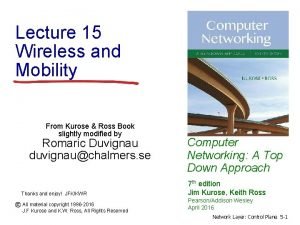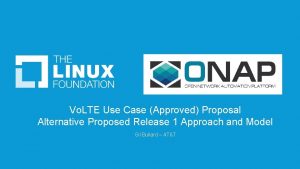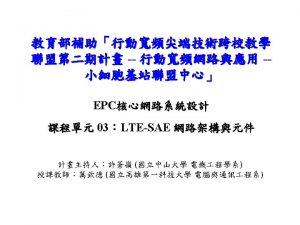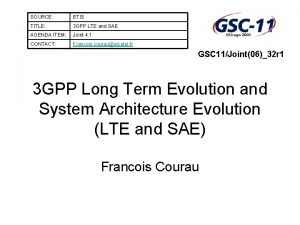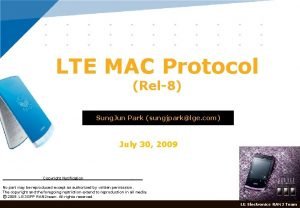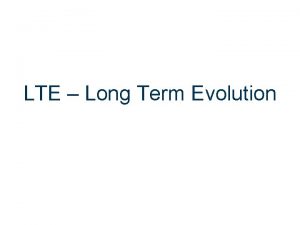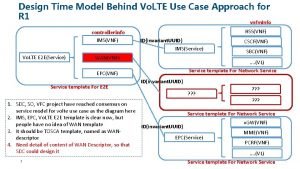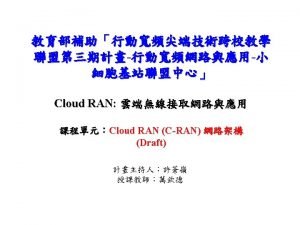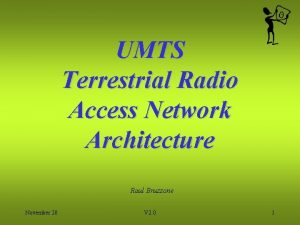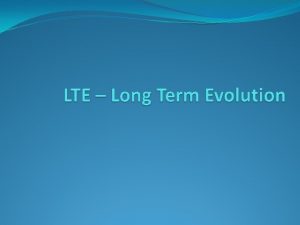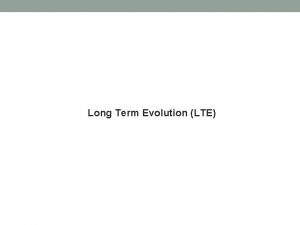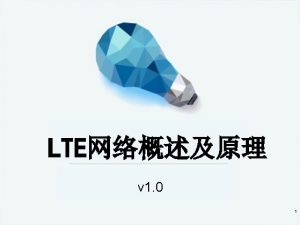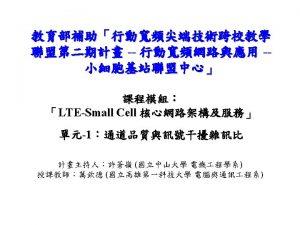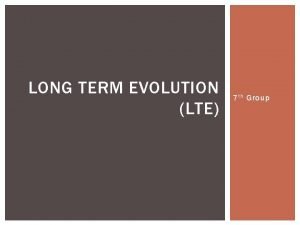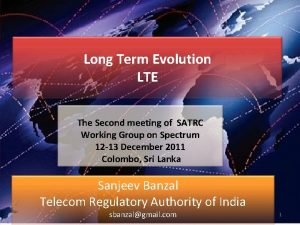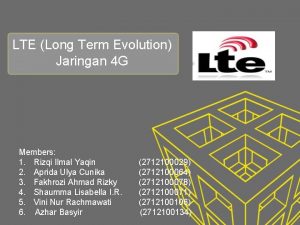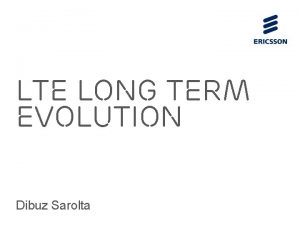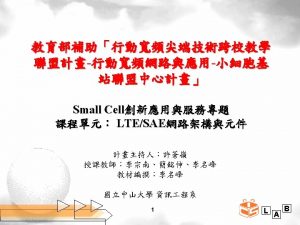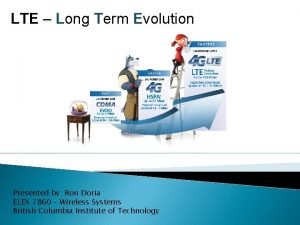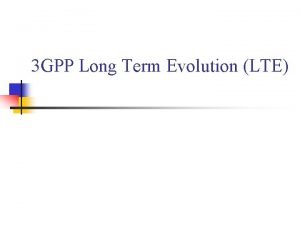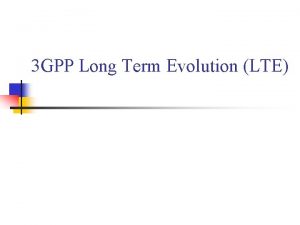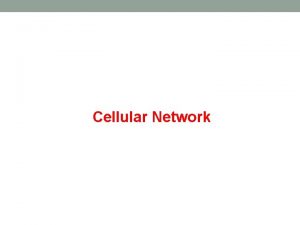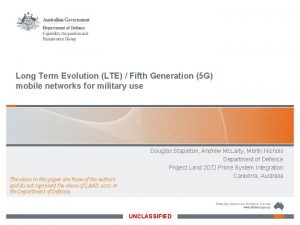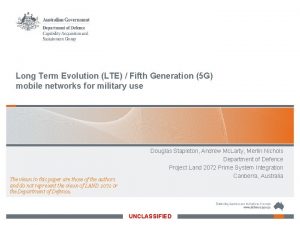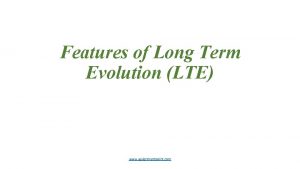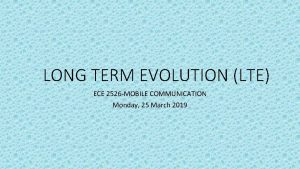LTE Long Term Evulation Evolution of Radio Access




























































- Slides: 60

LTE (Long Term Evulation)

Evolution of Radio Access Technologies 802. 16 m 802. 16 d/e 2

WIRELESS ACCESS EVOLUTION Subscribers § New Services § Efficiency § Voice Quality § Portability § Capacity § Data Service § Coverage § Mobility Voice Broadband § More Data Services required § Broadband § Network Simplification § Cost of Ownership

What is 3 GPP? n n 3 GPP stands for 3 rd Generation Partnership Project It is a partnership of 6 regional SDOs (Standards Development Organizations) Japan USA n These SDOs take 3 GPP specifications and transpose them to regional standards

Two Key technologies are evolving to meet the Wireless Broadband Requirements MOBILE BROADBAND Metro Area Nomadic GSM GPRS EDGE UMTS HSPA LTE 3 GPP 802. 16 e (Mobile WIMAX) Mobile Industry 802. 16 a/d (Fixed NLOS) Fixed Wireless Industry Local Area Fixed Coverage/Mobility Wide Area Mobile 4 G Air Interfaces Dial Up DSL Experience Fibre Experience Data Rates (kbps) Higher Data Rate / Lower Cost per Bit 802. 16 (Fixed LOS) 802. 11 n (smart antennas) 802. 11 Mesh extns. 802. 11 b/a/g 100, 000 + 5

COMPARISON WITH SPEED 40 -100 Mbps Fiber like speed on mobile + True high-speed mobile data + Full-motion HD video anywhere + Stream any content + Mobile peer 2 peer & Web 2. 0 EDGE ADSL (Networking) EVDO-A HSDPA ADSL-2+ + Triple play LTE Fiber Mbps

COMPARISN COST + Spectral efficiency Better utilization of spectrum available + Low frequency, Advanced Receivers and Smart Antenna For improved coverage and reduced cost of ownership + Increased Capacity Much higher user and sector throughput for lower individual cost service delivery $ UMTS rel. 99 voice call cost 10% LTE Vo. IP cost* Predicted LTE Vo. IP voice call cost* - Sound Partners Limited Research + Simpler RAN, IP Core & Centralized service delivery Fewer nodes & interfaces (Node. B/RNC/Gateway) One Network & IMS for all access technologies + Connect to legacy cores Existing network asset investment protection + 3 GPP/2 Market traction 3 GPP subscribers 85% market share Economy of scale

RESPONSE TIME 10 -5 msec latency Highly Responsive Multimedia + Improved user experience + Fast Vo. IP call set-up + Instantaneous web pages + Streaming fast buffering EDGE ADSL EVDO-A HSDPA ADSL-2+ LTE Fiber + Online mobile gaming

What is EPC, e. UTRAN and EPS CS networks Core Network 2 G Circuit Core 3 G User mgmt e. UTRAN IMS domain EPC Non-3 GPP EPC = Evolved Packet Core (SAE) e. UTRAN = Evolved UTRAN ( LTE RAN ) EPS = Evolved Packet System incl EPC, e. UTRAN and terminals (LTE/SAE terminology only used within 3 GPP standardization workgroups) ”IP networks”

LTE Offer’s n Performance and capacity DL 100 Mbps AND UL 50 Mbps n Simplicity Flexible Bandwidths (5 Mhz-20 Mhz), FDD and TDD plug-and-play Devices self-configuration Devices self-optimization Devices

LTE ACCESS n LTE radio access q q Downlink: OFDM Uplink: SC-FDMA OFDMA SC-FDMA n Advanced antenna solutions q q q n Diversity Beam-forming Multi-layer transmission (MIMO) TX TX Spectrum flexibility q q q Flexible bandwidth New and existing bands Duplex flexibility: FDD and TDD 1. 4 MHz 20 MHz

FREQUENCY BEND

LTE – Long Term Evolution Channels

LTE (Long Term Evolution) n Radio Side (LTE – Long Term Evolution) q q q n Improvements in spectral efficiency, user throughput, latency Simplification of the radio network Efficient support of packet based services Network Side (SAE – System Architecture Evolution) q q Improvement in latency, capacity, throughput Simplification of the core network Optimization for IP traffic and services Simplified support and handover to non-3 GPP access technologies

LTE ARCHITECTURE Evolved Packet Core MME/UPE = Mobility Management Entity/User Plane Entity e. NB = e. Node. B

EVOLVED PACKET CORE NETWORK P-GW/S-GW E P Interfaces MME MME S 11 C S 1 -Cp X 2 Gi E U T R A N LTE NODE B LTE NODE B Air Interface

LTE/SAE Architecture 3 G NETWORK IP networks Only PS Domain shown Gi HLR/HSS Gr Gn Gn GGSN SGSN Gb Iu BSC RNC BTS Node B 2 G 3 G Iur

LTE/SAE Architecture HSPA (HIGH SPEED PACKET DATA ACCESS) IP networks Only PS Domain shown Gi HLR/HSS PCRF Gr Gx Gn GGSN SGSN Gb Iu CP Iu UP BSC RNC BTS Node B 2 G Optimizing the 3 G/HSPA payload plane for Broadband traffic Iur 3 G Release 7 ”Direct Tunnel”

LTE/EPC Network Architecture GGSN => Packet Gateway SGSN => Mobility server IP networks GGSN/ P/S-GW SGSN/ MME EPC BSC RNC GSM, WCDMA MME = Mobility Management Entity P/S-GW = PDN/Serving gateway LTE

LTE/SAE Architecture LTE/SAE Only PS Domain shown The PDN and Serving GW may be separate nodes in some scenarios (S 5 in-between) HLR/HSS IP networks SGi PCRF Gr S 6 a S 7 S 4 SGSN S 3 MME S 11 PDN GW Serving GW S 2 a/b S 10 Gb Iu CP Iu UP S 1 -MME BSC RNC S 1 -U Iur e. Node. B BTS 2 G X 2 Node B 3 G LTE Non-3 GPP access A flat architecture for optimized performance and cost efficiency

KEY NODES OF LTE SGi SGSN n MME Functionality S 3 MME S 4 S 11 SAE GW S 10 S 1 -MME Responsibilities is to keep track of terminals in idle Mobility handling Authentication Roaming S 1 -U e. Node. B SGSN can be software upgraded to a MME and after that function as a combined SGSN and MME X 2

SAE GW Functionality SGi SGSN n S 3 PDN SAE GW (ANCHOR) MME S 4 S 11 SAE GW S 10 S 1 -MME q n q q q n e. Node. B Anchor for mobility non 3 GPP Network (Wimax and other Network) Serving SAE GW: q S 1 -U Routing Anchor inter 3 -GPP mobility (GSM/3 G/4 G Netowork) Security Lawful Intercept P/S-GW node, which also can be a software upgrade of a current GGSN node. X 2

SAE CN Architecture LTE/SAE Architecture Main SAE interfaces (non-roaming case) n n n n n *) S 1 -MME: IP networks control plane protocol between OSS-RC e. Node. B and MME (SGi) S 1 -U: user plane tunneling interface SGi between e. Node. B and Serving GW SAE GW S 5: S 5/S 8 (in some use cases only) user plane tunneling interface S 4 between Serving GW and PDN GW SAE GW S 11 S 3 S 8: SGSN MME user plane tunneling interface between Serving GW and PDN GW S 10 for roaming S 10: S 1 -U S 1 -MME control plane interface between MME and MME S 11: control plane interface between MME X 2 e. Node. B and Serving GW. S 4: *) user plane tunneling interface between SGSN and PDN GW S 3: *) control plane interface between MME Note: Interfaces non-3 GPP accesses not covered. and SGSN.

CALLING PATH FROM 2 G TO 3 G NETWORKS

BSC BTS A 2 G Subscriber Node B A 3 G Subscriber RNC e. Node. B A LTE Subscriber SGSN MME S-GW HLR/HSS P-GW IP Network, Internet /Services B 3 GPP PCRF B Non 3 GPP 25

BSC BTS A 2 G Subscriber Node B A 3 G Subscriber RNC e. Node. B A LTE Subscriber SGSN MME S-GW HLR/HSS P-GW IP Network, Internet /Services B 3 GPP PCRF B Non 3 GPP 26

BSC BTS A 2 G Subscriber Node B A 3 G Subscriber RNC e. Node. B A LTE Subscriber SGSN MME S-GW HLR/HSS P-GW IP Network, Internet /Services B 3 GPP PCRF B Non 3 GPP 27

BSC Base Station Controller n n The call request reaches the BSC from the BTS and is forwarded to SGSN. After call is established, the BSC will perform decoding of the call (in typical config. ) 28

BSC BTS A 2 G Subscriber Node B A 3 G Subscriber RNC e. Node. B A LTE Subscriber SGSN MME S-GW HLR/HSS P-GW IP Network, Internet /Services B 3 GPP PCRF B Non 3 GPP 29

BSC BTS A 2 G Subscriber Node B A 3 G Subscriber RNC e. Node. B A LTE Subscriber SGSN MME S-GW HLR/HSS P-GW IP Network, Internet /Services B 3 GPP PCRF B Non 3 GPP 30

SGSN Serving GPRS Support Node n n SGSN used for packet routing. It also working as MSC/VLR The SGSN used in 2 G/3 G networks is converted to a Mobile Management Entity, MME. SGSN says I don’t know the location of subscriber B so that’s why I am sending the request to HLR for finding the location. 31

BSC BTS A 2 G Subscriber Node B A 3 G Subscriber RNC e. Node. B A LTE Subscriber SGSN MME S-GW HLR/HSS P-GW IP Network, Internet /Services B 3 GPP PCRF B Non 3 GPP 32

BSC BTS A 2 G Subscriber Node B A 3 G Subscriber RNC e. Node. B A LTE Subscriber SGSN MME S-GW HLR/HSS P-GW IP Network, Internet /Services B 3 GPP PCRF B Non 3 GPP 33

HSS/HLR Home Subscription Server / Home Location Register • The HSS/HLR stores all the user data. • It registers the location of the user in the visited network. • HLR/HSS says ’I am the home of the B subscriber and I know where he/she is right now • It tells to the SGSN back. 34

BSC BTS A 2 G Subscriber Node B A 3 G Subscriber RNC e. Node. B A LTE Subscriber SGSN MME S-GW HLR/HSS P-GW IP Network, Internet /Services B 3 GPP PCRF B Non 3 GPP 35

BSC BTS A 2 G Subscriber Node B A 3 G Subscriber RNC e. Node. B A LTE Subscriber SGSN MME S-GW HLR/HSS P-GW IP Network, Internet /Services B 3 GPP PCRF B Non 3 GPP 36

SGSN Serving gateway Support Node • It says OK I collected the information about subscriber and store it temporarily. • I am sending to the information to P-GW & S-GW by MME 37

BSC BTS A 2 G Subscriber Node B A 3 G Subscriber RNC e. Node. B A LTE Subscriber SGSN MME S-GW HLR/HSS P-GW IP Network, Internet /Services B 3 GPP PCRF B Non 3 GPP 38

BSC BTS A 2 G Subscriber Node B A 3 G Subscriber RNC e. Node. B A LTE Subscriber SGSN MME S-GW HLR/HSS P-GW IP Network, Internet /Services B 3 GPP PCRF B Non 3 GPP 39

MME Mobility Management Entity MME Functionality Responsibilities is to keep track of terminals in idle Mobility handling Authentication Roaming 40

BSC BTS A 2 G Subscriber Node B A 3 G Subscriber RNC e. Node. B A LTE Subscriber SGSN MME S-GW HLR/HSS P-GW IP Network, Internet /Services B 3 GPP PCRF B Non 3 GPP 41

BSC BTS A 2 G Subscriber Node B A 3 G Subscriber RNC e. Node. B A LTE Subscriber SGSN MME S-GW HLR/HSS P-GW IP Network, Internet /Services B 3 GPP PCRF B Non 3 GPP 42

P-GW/ S-GW Packet Data Network Gateway/ Serving P-GW It uses for switching and mobility management between subscriber. Serving SAE GW: Routing Anchor inter 3 -GPP mobility (GSM/3 G/4 G Network) Security Lawful Intercept It is the IP point of attachment for the user. The P-GW allocates the IP address to the user A, that enables it to communicate with other IP hosts in the external networks, or the internet. 43

BSC BTS A 2 G Subscriber Node B A 3 G Subscriber RNC e. Node. B A LTE Subscriber SGSN MME S-GW HLR/HSS P-GW IP Network, Internet /Services B 3 GPP PCRF B Non 3 GPP 44

BSC BTS A 2 G Subscriber Node B A 3 G Subscriber RNC e. Node. B A LTE Subscriber SGSN MME S-GW HLR/HSS P-GW IP Network, Internet /Services B 3 GPP PCRF B Non 3 GPP 45

PCRF Policy & Charging Resource Function • The PCRF is the network element that is responsible for Policy and Charging Control. • it performs decisions on how to handle the service in terms of Qo. S (Quality of Service). 46

BSC BTS A 2 G Subscriber Node B A 3 G Subscriber RNC e. Node. B A LTE Subscriber SGSN MME S-GW HLR/HSS P-GW IP Network, Internet /Services B 3 GPP PCRF B Non 3 GPP 47

BSC BTS A 2 G Subscriber Node B A 3 G Subscriber RNC e. Node. B A LTE Subscriber SGSN MME S-GW HLR/HSS P-GW IP Network, Internet /Services B 3 GPP PCRF B Non 3 GPP 48

P-GW/ S-GW • It takes information from PRCF • PRCF provides information to the PCEF (Policy and Charging Enforcement Function) located in the P-GW, after verify the charging functionality. • If necessary to BBERF (Binding and Event Reporting Function) located in the SGW, to set up the appropriate bearers and policy. 49

BSC BTS A 2 G Subscriber Node B A 3 G Subscriber RNC e. Node. B A LTE Subscriber SGSN MME S-GW HLR/HSS P-GW IP Network, Internet /Services B 3 GPP PCRF BSC B Non 3 GPP 50

Mobile broadband speed evolution LTE Evolution LTE HSPA Evolution HSPA 3 G- R’ 99 Peak rate 384 kbps 2002 3. 6 Mbps 2005 7/14 Mbps 2007 21/28/42 Mbps ~150 Mbps Target 1 Gbps 2008/2009 2013

LTE All-IP RAN OVERVIEW RBS site Mobile backhaul Switching site All-IP, 3. . 4 Co. S classes 2 G Microwave BSC IP/MPLS Copper (metro ethernet) 3 G RNC Fibre SGW LTE Metro, HRAN Access, LRAN e. Node. B LRAN HRAN SGw • Peak rates: 150. . 300 Mpbs • L 2 or L 3 possible • L 3, IP/MPLS • Fibre/microwave to site • Router somewhere in the LRAN/HRAN network • Redundancy • Located at Switching Site • E-LAN or E-Line • Security GW, if IPsec used No Revolution - Just Evolution of Existing Infrastructure

LTE/SAE Architecture Product dimension PA/DU Core & IMS IP networks SGi HLR/HSS ”HLR/HSS” Gr PCRF S 6 a S 4 SGSN MME S 3 S 11 ”Mobility Server”S 10 Gb Iu CP PDN GW Serving GW BTS 2 G S 2 a/b ”Gateway” Iu UP S 1 -MME BSC S 7 EPC RNC Iur S 1 -U RBS e. Node. BB e. Node PA/DU Radio X 2 Node B 3 G LTE OSS Non-3 GPP access

THANKS


LTE SECRETS n n 2 main issues have been investigated: q The physical layer q The access network internal architecture Physical layer q Downlink based on OFDMA n q Uplink based on SC-FDMA n n q SC-FDMA is technically similar to OFDMA but is better suited for uplink from hand-held devices (battery power considerations) For both FDD and TDD modes (User Equipment to support both) n n OFDMA offers improved spectral efficiency, capacity etc With Similar framing + an option for TD SCDMA framing also Access Network consideration q For the access network it was agreed to get rid of the RNC which minimized the number of nodes

LTE RELEASE Ø Release 99 (2000): UMTS/WCDMA Ø Release 5 (2002) : HSDPA Ø Ø Ø Release 6 (2005) : HSUPA, MBMS (Multimedia Broadcast/Multicast Services) Release 7 (2007) : DL MIMO, IMS (IP Multimedia Subsystem), optimized real-time services (Vo. IP, gaming, push-to-talk). Release 8(2009) : LTE (Long Term Evolution)

IP Networks. General concepts n OSI model (1978) q Based on 7 layers

OSI and SS 7 Model OSI SS 7

Layers Description Packet Data Convergence Protocol (PDCP) n Performs IP header compression n Reduces the number of bits to transmit over the radio n Interfaced n Based on Robust Header Compression (ROHC) Radio Link Control (RLC) n Responsible for n Segmentation/concatenation n Retransmission handling n In-sequence delivery to higher layers n Located in the e. Node. B since no higher layers exists in LTE n In WCDMA this was handled higher in hierarchy Medium Access Control (MAC) n Responsible for n Uplink/downlink scheduling n Hybrid-ARQ retransmissions n Choice of modulation n Resource assignment Physical Layer (PHY) n Responsible for n Coding/decoding n Modulation/demodulation n Resource mapping
 Evulation
Evulation Ofdm
Ofdm Short, medium and long term planning in education
Short, medium and long term planning in education Long term memory vs short term memory
Long term memory vs short term memory Example of short term human resources
Example of short term human resources Difference between long term and short term liabilities
Difference between long term and short term liabilities Long-term liabilities examples
Long-term liabilities examples Short term goal
Short term goal Research paper on financial planning and forecasting
Research paper on financial planning and forecasting Tall + short h
Tall + short h Once upon a time there lived a girl
Once upon a time there lived a girl Trunking vs conventional radio system
Trunking vs conventional radio system Mpls over lte
Mpls over lte Mobility mode
Mobility mode Transmit diversity in lte
Transmit diversity in lte Paging in lte
Paging in lte Frame structure in lte
Frame structure in lte Breaking lte on layer two
Breaking lte on layer two Lte attach procedure
Lte attach procedure Lte τεστ προσομοιωσης
Lte τεστ προσομοιωσης Vo ltez
Vo ltez Qoffset
Qoffset Tactical lte
Tactical lte Congress of vienna simulation
Congress of vienna simulation Lte nas procedures
Lte nas procedures Lte backhaul architecture
Lte backhaul architecture Lte full duplex
Lte full duplex Lteinspector
Lteinspector V lte symbol on phone
V lte symbol on phone Gpp lte means
Gpp lte means 0 172
0 172 Gpp lte meaning
Gpp lte meaning Physical layer in lte
Physical layer in lte Lte network architecture
Lte network architecture V0 lte
V0 lte Lte vo
Lte vo System architecture evolution
System architecture evolution Gpp lte
Gpp lte Sung jun park
Sung jun park Dtch lte
Dtch lte V0 lte
V0 lte Centralized radio access network
Centralized radio access network Umts network architecture
Umts network architecture Radio access network
Radio access network Terminal access controller access-control system
Terminal access controller access-control system Terminal access controller access-control system
Terminal access controller access-control system Term-to-term rule
Term-to-term rule Quadratic sequences
Quadratic sequences Position to term rule worksheet
Position to term rule worksheet Minterm and maxterm expansion
Minterm and maxterm expansion Nth term rule
Nth term rule Term to term rule
Term to term rule Wisconsin long term care partnership program
Wisconsin long term care partnership program Long term financing
Long term financing Goals in grade 11
Goals in grade 11 Long term scheduler
Long term scheduler Dts city pairs
Dts city pairs Stress leave manitoba
Stress leave manitoba Long term impacts of the industrial revolution
Long term impacts of the industrial revolution The long-term future of particle accelerators
The long-term future of particle accelerators What are the causes of world war 2
What are the causes of world war 2
